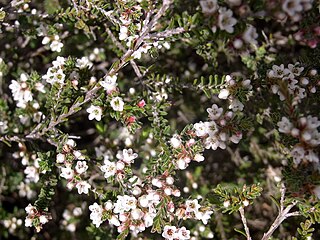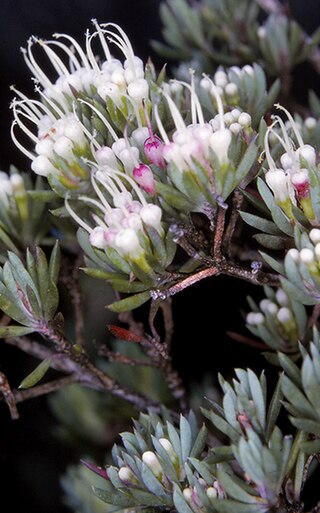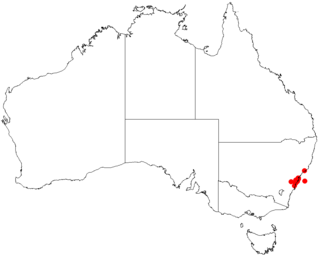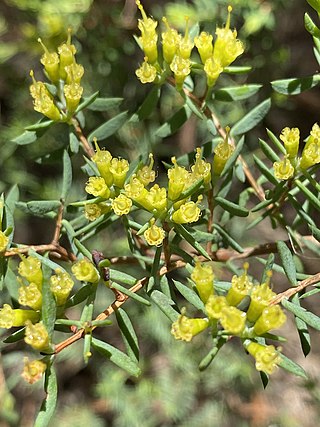
Darwinia, sometimes commonly known as mountain bells or simply bells, is a genus of about 70 species of evergreen shrubs in the family Myrtaceae, endemic to southeastern and southwestern Australia. The majority are native to southern Western Australia, but a few species occur in South Australia, New South Wales and Victoria. The genus was named in honour of Erasmus Darwin, grandfather of Charles Darwin by Edward Rudge in 1816. Most darwinias grow to a height of between 0.2 and 3 m, and many are prostrate shrubs. Most have small, simple leaves and the flowers are often grouped together, each flower with five red, white or greenish petals and ten stamens. In many species, the flowers are surrounded by large, colourful bracts, giving rise to their common names.

Darwinia citriodora, commonly known as lemon-scented darwinia or lemon scented myrtle, is a plant in the myrtle family Myrtaceae and is endemic to the south-west of Western Australia. It is a shrub with oblong to lance-shaped leaves and red, yellow and orange flowers over an extended period. It is a hardy plant in well-drained soil, is often cultivated and used as a rootstock for less hardy species.

Darwinia taxifolia is a species of flowering plant in the myrtle family Myrtaceae and is endemic to New South Wales. It is an erect or low-lying shrub with laterally compressed leaves. The flowers are pink or purplish and usually arranged in groups of two to four.

Grevillea shiressii is a species of flowering plant in the family Proteaceae and is endemic to New South Wales where it is found in only two localities near Gosford. It is an erect shrub with oblong to narrowly lance-shaped and small clusters of green to bluish-grey, later cream-coloured flowers with a brownish-maroon style.

Micromyrtus blakelyi is a species of flowering plant in the family Myrtaceae and is endemic to a small area near Sydney Australia. It is a low, cushion-like shrub with overlapping, keeled, linear leaves and small pink flowers arranged singly in upper leaf axils.

Homoranthus darwinioides, commonly known as fairy bells, is a species of flowering plant in the family, Myrtaceae. It is a small, spreading shrub with pendulous yellow and pink flowers, grey-green leaves and is endemic to New South Wales.

Darwinia grandiflora is a flowering plant in the family Myrtaceae. It is a dense, mat forming, prostrate shrub with clusters of tubular red flowers and is endemic to New South Wales.

Olearia asterotricha, commonly known as rough daisy-bush, is a species of flowering plant in the family Asteraceae. A tall shrub with white, mauve or blue daisy like flowers growing from the Blue Mountains in New South Wales to western Victoria, Australia.

Darwinia briggsiae is a plant in the myrtle family Myrtaceae and is endemic to New South Wales. It is an erect shrub with linear-shaped leaves and small groups of pink and white flowers.

Darwinia biflora is a plant in the myrtle family Myrtaceae and is endemic to New South Wales. It is an erect, often straggly shrub with flattened, glabrous leaves, and flowers which are arranged in pairs. The flowers are greenish in colour but each is surrounded by two purple-red bracteoles and have a long yellow-green style projecting out of the flower tube. The species only occurs in the Sydney region in a few places where shale-capped ridges intergrade with Hawkesbury sandstone.

Darwinia camptostylis is a plant in the myrtle family Myrtaceae and is endemic to New South Wales and Victoria. It is small shrub with flattened, glabrous leaves and small clusters of green to yellow flowers. There are scattered populations in coastal areas where the plants grow in heath.

Darwinia procera is a plant in the myrtle family Myrtaceae and is endemic to a small area in New South Wales. It is a shrub with laterally compressed leaves, so that they are thicker than wide. The flowers are reddish-purple and arranged in groups of four near the ends of the branches. Although rare in nature, this species is often grown by native plant enthusiasts.
Darwinia terricola, commonly known as the Blackwood bell, is a species of flowering plant in the myrtle family Myrtaceae and is endemic to a small area in the south-west of Western Australia. It is a small, low, sometimes prostrate shrub with small, linear leaves and small groups of flowers surrounded by reddish-green bracts and which usually lie on the ground.

Darwinia thymoides is a species of flowering plant in the myrtle family Myrtaceae and is endemic to the south-west of Western Australia. It is a low, spreading to prostrate shrub with linear to lance-shaped leaves and groups of 4 to 8 green, red or white flowers surrounded by leaf-like bracts.

Darwinia peduncularis is a species of flowering plant in the myrtle family Myrtaceae and is endemic to the Sydney region in New South Wales. It is a shrub with flattened leaves and purplish red flowers usually arranged in pairs.

Darwinia diminuta is a plant in the myrtle family Myrtaceae and is endemic to New South Wales. A small spreading shrub with white to pinkish tubular flowers arranged in pairs, with a restricted distribution mostly in the Sydney region.

Homoranthus lunatus, commonly known as crescent-leaved homoranthus, is a flowering plant in the family Myrtaceae and is endemic to a small area in northern New South Wales. It is a spreading shrub with curved leaves and small groups of up to six yellow flowers in leaf axils.

Muellerina bidwillii, common name Cypress-pine mistletoe, is a hemiparasitic aerial shrub in the family Loranthaceae. The species is endemic to New South Wales and Queensland.

Podolobium scandens, commonly known as netted shaggy-pea, is a flowering plant in the family Fabaceae and is endemic to eastern Australia. It is a prostrate, small shrub with orange-yellow pea-like flowers and red markings.

Darwinia leptantha is a flowering plant in the family Myrtaceae. It is an upright, small shrub with white flowers turning pink with age, triangular-shaped leaves and is endemic to New South Wales.




















